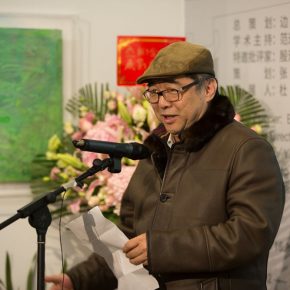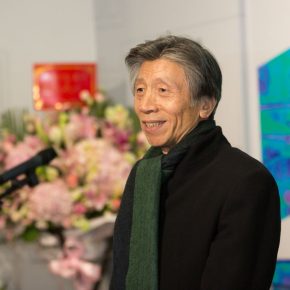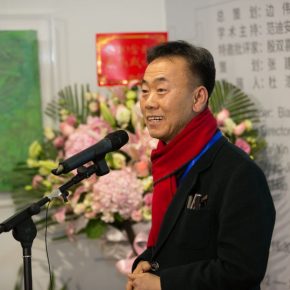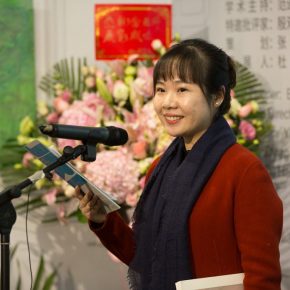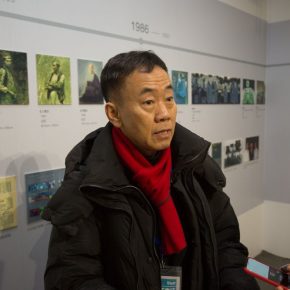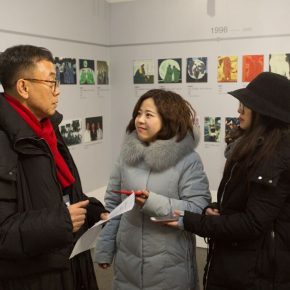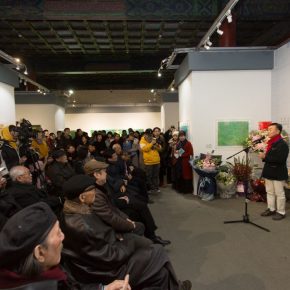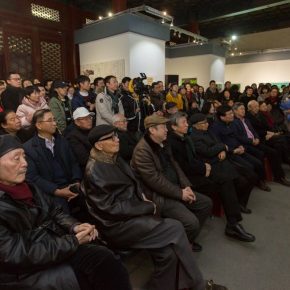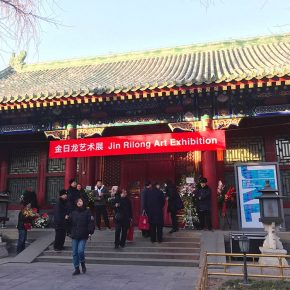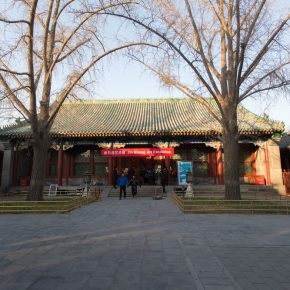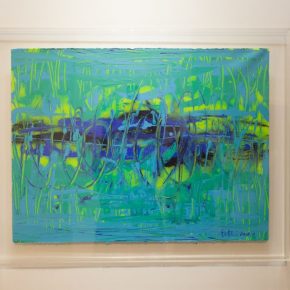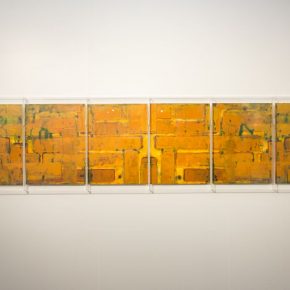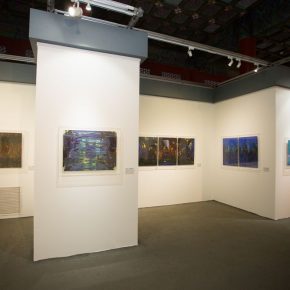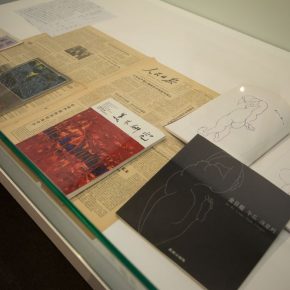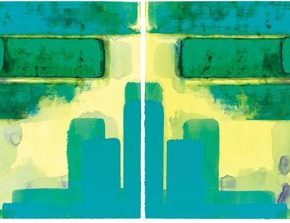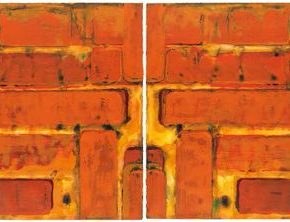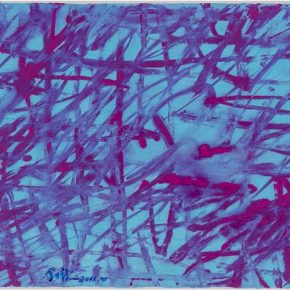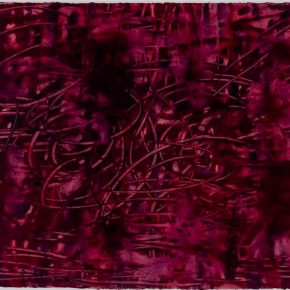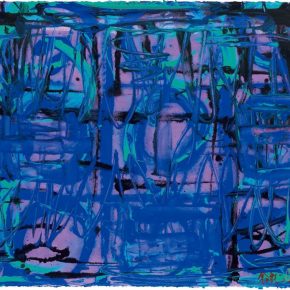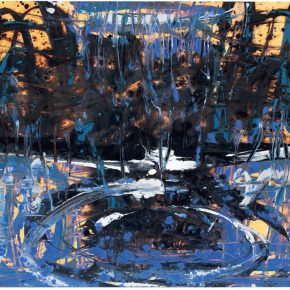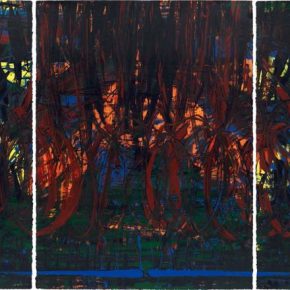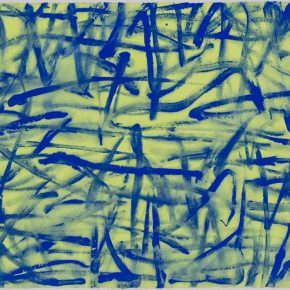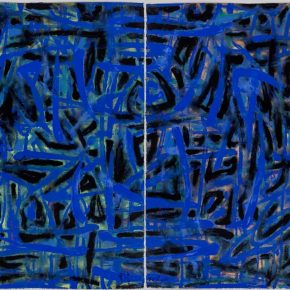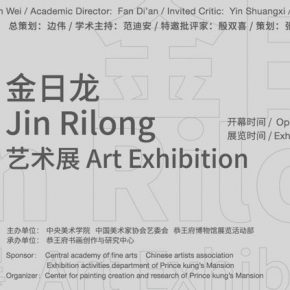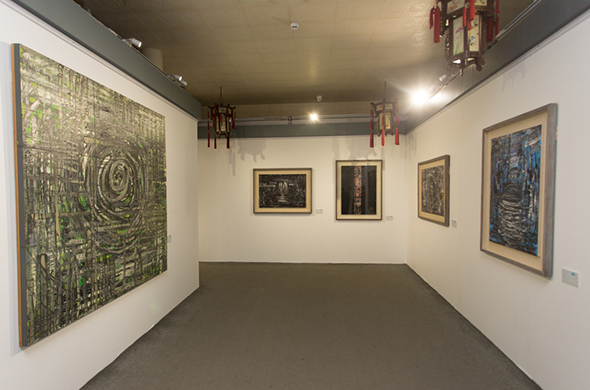
The “images”?in themsuch as the new green sprouts on the earth,
blue elves in moonlit nights,
Or a splendid jungle in the autumn wind...
—An Excerpt from?“Jin Rilong: Imprints of Changes and Conservation”?by Fan Di’an
Mr. Jin Rilong has multiple identities, which might?contain a little bit of legendary color. In the eyes of students who are familiar with him, he is a gentle?and easy-going professor based at?Design School?of Central Academy of Fine Arts(abbr. CAFA);?for his?colleagues?he is an outstanding comrade in administrative work; it is little known that he?is a Korean artist from the Yanbian Autonomous Prefecture of Jilin Province in Northeast China. In the late 1970s, after the national education reform, he was admitted to Yanbian University. His oil painting “Grandma” created in 1982 won the Gold Medal in the First National Ethnic Minority Fine Arts?Exhibition. Later, he was enrolled in the First Studio of the Oil Painting Department at?the Central Academy of Fine Arts?and thus he?has a solid foundation in modeling.?From 1996?through?to 2005, he successively obtained Master’s and Doctoral degrees from Seoul's most famous Seoul National University and Hongik University. Since his return?to China in 2006, he has?taught at the College of Design and served in an administrative position in?CAFA. Although he has been occupied with work, which makes us curious about how he uses his fragments of time to conduct rich creations, concerning art, how does he have such an enthusiastic heart?
In the late 1990s, Mr. Jin Rilong held four solo exhibitions in South Korea. On December 12, 2018, the “Jin Rilong?Art Exhibition" was unveiled?in Jiale Hall, Prince Kung’s Mansion, Beijing. This was?his first solo exhibition in China. The exhibition was academically chaired by Mr. Fan Di’an, President?of the Central Academy of Fine Arts?and a special?invitation was extended to the critic Mr. Yin Shuangxi?to review his art, and it was curated by Dr. Du Hao, Curator of Prince Kung’s Mansion. The Central Academy of Fine Arts, the Artists’ Committee of the China?Artists Association, and the Painting and Calligraphy Creation and Research Center?of Prince Kung’s Mansion?served as?the organizers?and sponsors?respectively. The exhibition showcased?the artistic creations of Professor Jin Rilong over the years, presenting a graphic?thinking analysis and contemporary vision of his works by?reorganizing his?artistic context. At the opening ceremony, many teachers and guests from CAFA?attended the event and it?was lively and extraordinary. Bian Wei, Deputy Director of the?Prince Kung’s Mansion, the Ministry of Culture and Tourism?as well as the?chief planner of the exhibition,?Jin Shangyi, the former President?of the Central Academy of Fine Arts, famous art historian Shao Dazhen, Party Secretary of the Central Academy of Fine Arts Gao Hong, and President?of the Central Academy of Fine Arts?Fan Di’an, briefly gave an address at the exhibition. After that?Professor Jin Rilong expressed his thanks to?the guests. The opening ceremony was hosted by Ms. Fu Yijing, Director of the Research Department of the Central Academy of Fine Arts.
“A Prince Kung’s Mansion, reflects half of the history of the Qing Dynasty,”?the Prince Kung’s Mansion itself is a typical symbol of Chinese culture, which is in contrast to the phenomenon of tourists?crowding?inside and outside the?mansion. As Fan Di’an, President?of the Central Academy of Fine Arts, said at the opening ceremony, “With this art exhibition being presented at Prince Kung’s?Mansion it has formed a dialogue between tradition and modernity.” Most of the works on display are abstract and the unbridled expressions?and the ingenious?mansion complemented?each other. A dramatic echo was?formed between them.?The?integration?of tradition and modernity was?both a?direct?reflection of the collision between the exhibition scene and the exhibited works?and they also sent?a signal that the artist Jin Rilong has been trying to express: in the integration of tradition and modernity, starting from the spiritual world, transforming and weaving the multiple factors, he tells stories?in his?own artistic language.
There are three galleries?in the Jiale?Hall exhibition area. Apart from some oil paintings from the late 1990s?that were exhibited at the East Gallery, most of the works in the Main Gallery?and the West Gallery?were?Jin’s recent works, and?they were based on acrylic paint. He honestly revealed his experience in creating these works, “because of the personnel management,?I have?very little time?to create, but I think every day, I?cannot let myself stop. Once the artist stops, he?will be finished, even if I sometimes just drew strokes, some works might?be finished in twenty minutes or half an hour which go?quite smoothly.” Unlike ordinary professional artists, Mr. Jin Rilong said that he could?only create by “squeezing?in time.” He?“hid” paintings in a corner of the office, after he returned?to the studio at?the end of the day to enjoy the most precious output time?with art?and other interesting things, his?description was?very visual,?as he has?been?devoted to art with his enthusiasm for life and work.?Meanwhile, he also joked that: "Even the work of personnel management has a great influence on my creations. Everyone thinks that I am an A-type?blood?guy, that is, a person who is rational.?Actually,?I am 'B-type blood', I am very?sensitive. I felt?disgusted when dealing?in personnel work at first, but when I got to the personnel office, I re-understood it. This is reality?we must confront, I?put?all these?experiences into my paintings,” his?plain and sincere?attitude and his love of?art permeated through his creations, his emotions were deposited?in colors?and his thoughts fermented at his strokes.
In addition to the direct role of his?administrative duties played in his art, the identity of the digital media teacher in design schools?in South Korea during his?study abroad has influenced his construction of the visual patterns?and a series of design elements directly manifested?in the pictures. For example, in his?work “Sunday,” three neon-like tube bands instantly occupy the eyeballs, cover up the dark light shining under the flighty brushstrokes, like the street light box that has not been extinguished in the morning fog, in this work, “stacked” feature?of the layers?are very significant, which coincides with the concept of “l(fā)ayered” drawing in the design composition. What's more, some works such as “Inside and Outside”, “Spring Cicada,”?the color strokes seem to be processed through?the “anti-color filter” in Photoshop;?in “Cultivation II”, large areas of dark and small rectangular flows into dense lines form a strong contrast of clues, while stable and powerful, active and vivid, full of vitality in rational control.?A strong sense of design, is a very prominent feature in its composition.?President Fan Di’an mentioned in his essay, “After turning to paintings in the abstract form, he further takes the ‘composition’?as his subject of exploration and research. He has tried a variety of media, thus he has either intruded on the different attributes of materials and made them become the carriers for his sensory feelings, or he has paid more attention to the diversified techniques in graphic performance with the combination of sensible portrayal and rational control. In terms of form and structure, he has remained flexible in various ‘manipulations’, they can be either comprehensively displayed, on a wide surface; or with dense lines which result in a tight texture; or through adjacent hues, forming soothing lyrics; or with contrasting colors to trigger strong tension. It is commendable that he pays attention to the interlaced texture within the structure, which means he does not only research the superficial forms of painting, he also stresses its deepening layers. He makes use of multiple level processing among thick and thin layers to achieve a rich and profound visual effect in his paintings.”
From the very solid academic style of painting in the early years to the later media installations and the abstract style of language of today, this “cliff-like” span arc is undoubtedly huge and the process of change and his life journey?is connected, change and conservation are dialectical organisms.?As Fan Di’an commented that “the most valuable quality of an artist does not lie in his changes in art styles, but in his constant spiritual pursuit.” It can be said that Mr. Jin Rilong’s personal experience and multiple identities have created the uniqueness of his artistic creation. The solid artistic style of painting and the modern design concept advancing with the times meet at a certain point, and the fragmentary information, the contextual characteristics of epochs overlap with the individual’s?life experience. He expresses his feelings?with a?heart of sincerity. As Mr. Shao Dazhen wrote, “The reason that his paintings could impress viewers does not lie in that his expressive form is realistic depiction, imagery manifestation or abstract scribbling, what is important is that the artist expresses the true feelings that he has gained from real life.”
Professor Jin Rilong’s creation in the “Jin Rilong Art Exhibition” in recent years is not limited to?his?continuous extension of technical materials in the planar figurative paintings?and abstract paintings. The combination of contemporary devices and digital multimedia is also his other manifestation in the investigation and judgment?of cultural tradition and contemporary art. With his persistence, Mr. Jin provides us with a paradigm that constantly breaks through limitations, and he presents the inner world and spiritual life of people using visual art with rich thinking. With the sincere words of the invited critic?for?this exhibition,?Professor Yin Shuangxi from the Central Academy of Fine Arts, who paid tribute to this respected professor, rigorous school worker and emotional artist, “we are looking forward to the deepening of Jin Rilong’s creation, and on the basis of the feelings about daily life, to gain insight into the silent, unnoticed, unrecognized and amazing world vision. It is in the ordinary space and objects which surround us that there is a mysterious existence hidden by our cultural heritage. We hope that Jin Rilong will bring us a more “unfamiliar”?spirit and lead us into the endless tunnel of life.”
“Jin Rilong Art Exhibition”—Interview with the Artist
CAFA ART INFO: Hello, Mr. Jin, first of all, congratulations on your exhibition. For you, this is the first time to present?a solo exhibition in China. Can you give us a brief introduction to the preparation and work that this exhibition entailed? In the process, do you have any insights or special comments you would like to share with us?
Jin Rilong: When I was in South Korea, I presented quite a few?exhibitions, four times in total, but I have been involved in teaching since I returned to China. It is difficult to present?exhibitions from a teaching post. In addition, there were?previously some group?exhibitions I often attended. However, this exhibition is totally different. I used to teach digital media in the School?of Design.
I have been working on creations with video media because after the changes?to my working position, I could not invest much time on videos, thus during?the rest of the time off duty, I just worked on easel paintings, this would?be more appropriate for me, I mean I do not want stop, once it stops, the artist is finished. So I took back a group of abstract paintings I painted in 1996. Most of the works included in this exhibition?are the latest collection of my abstract paintings, but from which my comprehension?and innovation of abstract art concepts?could be found. How to showcase the Eastern ideological concepts from points, lines, and surfaces? How to distinguish and express the “image” and “abstract” art? From constant planarization and expression?direct?to the?painting, I have been exploring the relationship between Eastern philosophy and visual forms.
Through?this exhibition, I especially want to thank my teachers?and colleagues, Jin?Shangyi, Zhan Jianjun, Shao Dazhen, Yuan Yunsheng, Pan Shixun, Guang Jun, Wen Guozhang, Sun Jingbo, Xu Bing, and the First Inspector of the Ministry of Education?Zhao Danling. President of Communication University of China?Liao Xiangzhong, etc. Mr. Jin Shangyi and Mr. Zhan Jianjun are the two teachers who liked?me the most when I studied at CAFA. Mr. Shao Dazhen?began to write articles for me in the 1980s. In order to learn Mr. Yuan Yunsheng’s?composition, in 1982 when I came to Beijing,?I rode my bicycle to the Capital Airport to see his murals. Lines and strokes?with a sense of speed can be seen in my abstract paintings. Mr. Pan Shixun was?my class adviser. Although Mr. Guang Jun and I have a huge gap in ages.?He?was?like my?buddy when we studied at CAFA. Although he was in the Printmaking Department, we were?very close. Mr. Wen Guozhang, who followed the instruction of?Mr. Jiang Feng?to recruit me to the Central Academy of Fine Arts. Xu Bing was a postgraduate student when I was an?undergraduate,?and he has paid close attention to my creations. They are all my special teachers and colleagues. After I called them, they all showed up. This is my treasure?and the biggest harvest?I have gained since I came to the Central Academy of Fine Arts.
CAFA ART INFO: Your choice to hold an exhibition at?Prince Kung’s Mansion?is quite special. The Prince Kung’s Mansion itself has its own rich historical and cultural background and?now?it is?a tourist attraction. What’s your thought on presenting?this exhibition here?
Jin Rilong: This is actually a rare chance. After I returned to China, I have no contact with any gallery, and I also had no contact with art museums. I always displayed some works when I was invited to participate in exhibitions. Prince?Kung’s Mansion?now belongs to the Ministry of Culture and Tourism. I want to “get contacted” from this kind of institution with a strong academic background. After an academic?exhibition is?finished, if it is popular, I will have the opportunity to bring it to?public view again. But that is the next step.
This spring I happened?upon this opportunity. When I was painting in the corridor, a teacher came across to me and asked why?I painted so much.?It is necessary to exhibit after painting. I didn't think about doing an exhibition at first, but later I thought it was a good suggestion. So with the encouragement and support from?many people, I began to prepare for the exhibition and I had a ?great amount of pressure.?Many people thought that I was diverted and I ceased to?paint. Therefore, I have to present something, and I felt disturbed and?embarrassed. This year is the centennial celebration of the Central?Academy of Fine Arts. I also wanted to contribute something to the?100th anniversary?of CAFA?at the end of this year. In addition, my teachers, including Mr. Jin?(Shangyi) and Mr. Yuan (Yunsheng), are getting?older. I wanted to report my achievements?when they are still with us. I wanted to tell them that as their student, I still keep painting. Originally, I wanted to?make a low-key?exhibition but now it turned out to be?a bit “excessive”, with the support of a lot of teachers, colleagues, and friends.
CAFA ART INFO: We noticed that there is no specific theme for?the exhibition. It is called “Jin Rilong Art Exhibition,”?why?
Jin Rilong: I had discussed?it?with President Fan before, and I was preparing to focus on a topic. Now many exhibitions are more poetic. I have also considered a literary?theme, but I don’t think it is necessary. Foreign artists'?solo?exhibitions don't specifically set a theme, just make a simple exhibition, and I did not want to present it in a large scale.
CAFA ART INFO: Therefore, a retrospective of?your artistic journey, from the early days of realistic paintings with realistic themes to the creation of human-painted paintings full of symbols and forms, and then gradually turning to modern abstract paintings. Recently, you have also created media art works. What kind of process is this huge?transformation for you?
Jin Rilong: I first graduated from the First Studio of the Oil Painting Department, but now I am engaged in an experimentally strong creative style as an artist. I have been moving forward, as President Fan (Di’an) said, since the reform and opening up an?artist's changed process has been reflected in my experience. I keep changing myself,?from the figurative painting to the influence of Chinese Dunhuang murals, and later in the graphic?paintings figures gradually?disappeared. There used to be?some images before, but only?the lines and colors were left on the surfaces,?telling some spiritual pursuits.
This exhibition is a series of graphic creations. When I first arrived at the personnel office, I placed four cameras?in the office. I would?continue to make creations. After Xu Bing came in (my office), I told him, now you are entering my work, later he asked me several times?whether I have finished my work which?he was very interested?in. Now in the personnel department, all my work?is related to people, including good and bad emotions. All four faces were?photographed. I originally prepared to complete it, but it has not been realized yet.
CAFA ART INFO: In the early years, you studied in the First Studio of the Oil Painting Department of the Central Academy of Fine Arts. After being influenced by Western classical oil painting tradition and a realistic style, you?later studied in South Korea. After returning to teach at the School of Design, you have?created a lot of works related to media and design. Have you come across?the contradiction between the two language forms of plastic arts?and design discipline? Or the contradiction between representation and abstraction? How to balance?them?
Jin Rilong: There will be conflicts and confusion. Usually?when I paint something, I feel?confused, and I want to adjust it?while painting. It is like often drinking coffee, I then want to drink some tea. But what we call figurative and abstract “figuration”?comes from the “figure” defined by human beings. We think that this “figure” is a “person”, not anything else, but when you see aliens, are they?abstract or figurative? In fact, the concept of figuration is artificially created. Give me a model, add some image photography and painting skills, and my thoughts and feelings can be integrated with them. I think the most difficult thing to do with a figurative thing, when a picture is placed in front of you, you I don’t know how to paint. The process of looking for figuration is to find spiritual things.?Once the spiritual figuration comes out, when it is accepted,?they will think that this is a “figuration” thing. Just as humans see themselves, what kind of facial features are “positive”, which have already been?defined.
CAFA ART INFO: I just had a tour around galleries. Are the?color relationships and feelings of the abstract paintings in the big exhibition hall related to your previous teaching in the School?of School? Your art experience showcases?a “cliff-style” transition, is this directly related to your living and working?environment?
Jin Rilong: We are now in the East Hall, these early abstract paintings, why would?I exhibit them this time? Here you can see the source of my recent?abstract paintings. In 1996, I did?not engage in?the design and images when I tried these abstract paintings. After this series?of paintings, I started to work on installations, and then added the?moving images, and then went to the School?of Design?to participate in the teaching, this process has a great impact on my creation. These early paintings are mainly?in?ink, usually?with?three colors, the background is colored, then the ink color and white are added. The series?that was recently completed was drawn on paper. The School of Design and the digital images?influenced me. I?began to create some design components?in color.?Some invisible things made the design move and the color was moving too. This is a static creation, but it is actually greatly influenced by what I learned from the School of Design.
After I went to work in the Personnel Department, the influence of personnel relations made me re-recognize people. I was very disgusted with people at first, but then I realized that this is human society and I re-understood it. Every time I return to the studio after work, it is the happiest time, the best time for my thoughts and ideas to come out. When I was painting there, the happiness was absolute and I feel extremely happy.
Therefore, at different stages, my creative context has changed a lot. It is indeed related to the dramatic changes in my life and working?environment, but in many cases it is also a bad time.?My classmates who?graduated from the traditional Department of Oil Painting and the Department of Chinese Painting, usually found it difficult to be removed from the restrictions.?On the contrary,?those from?the Printmaking Department and the Sculpture Department were very active. I think the only thing that needs to be changed here is myself. A lot of people said that I am a typical A-blood?guy. In fact, I am B-blood. I look like a?rational person?but actually I am very sensitive inside.
CAFA ART INFO: “Change” and “Conservation” can be said to be the characteristics of your artistic creation. Just now we talked about the dramatic changes in the way and style of your creations. So, for you, there is nothing that you have never changed, and kept thinking and persisting?
Jin Rilong: The thing that has not changed, I think it is a painting and visual thing that is different from the text. Give me material, now a digital media material, used to be oil brush and canvas. These things can express my “conservation.” I want to use materials to express my spirit, not words, and some things can never be performed. Now the new media work will do that for the time being, because it requires more energy and time. But I won't stop painting. I think only about that every day. Even if this painting is not done, some paintings will come out in half an hour. Some paintings can't be painted in two or three days. In short, I can't stop.
Interview conducted by Zhu Li/CAFA ART INFO
Text by Zhang Yizhi, translated and edited by Sue/CAFA ART INFO
Photo by Yang Yanyuan/CAFA ART INFO, Work Photo Courtesy of the Artist


